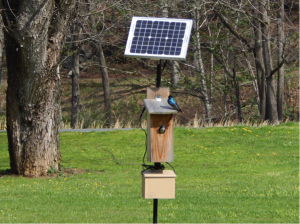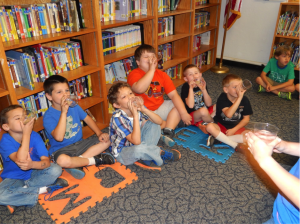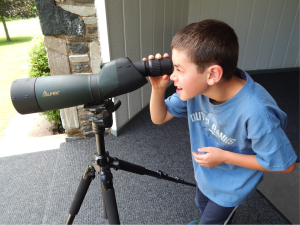Please welcome guest-blogger and Audubon NC field biologist Aimee Tomcho. Find out how local schools are cultivating a love of birding and participating in NestWatch programs in Western North Carolina.
Nest boxes are cropping up across North Carolina to provide homes for an array of cavity nesting bird species. In Western North Carolina, Tree Swallows are receiving the bird-friendly treatment by making a home in nest boxes provided by local schools. And new technology combining a nest box, solar panels and bird-monitoring cameras allows students to get the bird’s eye view of their neighborhood Tree Swallows.
Tree swallows are summer residents in the central and western regions of North Carolina and are known for their striking iridescent back feathers and clean white chest feathers. They eat flying insects through an amazing show of aerial acrobatics. They can be fairly aggressive territory defenders and often displace Eastern bluebirds from nest boxes. Nevertheless, tree swallows have helped researchers make major advances in several branches of ecology, and they are among the best-studied bird species in North America
In 2012, an elementary school in Yancey County received a very special gift: a nest box equipped with a solar-powered wireless camera. With that box, the school became one of eight North Carolina schools to participate in NC Nest Watchers.
The NC Watchers are a network of elementary school students, teachers and biologists participating in a project to monitor nesting birds across the state. Thanks to initial funding from the US Fish & Wildlife Service, and in cooperation with the NC Wildlife Resources Commission, students are able to use bird biology as a mechanism for learning science, math, art and more.
This year at Clearmont Elementary School in Burnsville, NC, tree swallows have made this nest box their home.
Every day this May, students watched the progress of the tree swallows as they entered the box. They observed how the birds built the nest using grasses and feathers on the live camera feed projected on a flat-screen television mounted in the school lobby. Even school visitors shared their excitement as they passed through the halls. The female tree swallow then laid one egg, two eggs, three eggs… All wondered if the next morning there would be another egg. After 6 days and 6 eggs, the female began incubating the eggs as she would continue to do for 11-20 days.
During this time every year, Audubon NC conservation biologist Aimee Tomcho volunteers to teach the students about avian ecology. This year, all the children in grades kindergarten through fifth grade participated in the “Breeding Bird Relay Race”. Using interconnecting foam squares as nesting material and fellow classmates as their bird family, they learned just how busy birds are by incubating eggs, feeding nestlings (using their cup mouths), and working hard to find and feed dispersing fledglings. Despite a few lurking predators, all of the students fledged successful nests!
After spending the last of their time together that day observing the real nest, the kids went home with hope that when they return to school on Monday, they may be greeted by their newly hatched tree swallows.
Do you have a school near you that would like to put up a nest box? Even without a camera, these boxes are welcome additions to most schoolyards. To learn more about nest boxes and how to build your own, visit our website.







